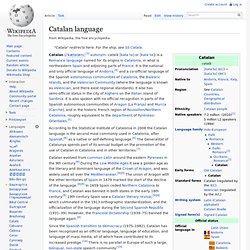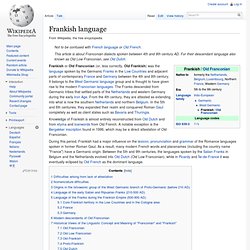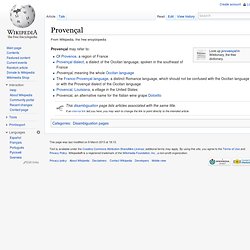

Oc Language History Provence, - by Provence Beyond. Stroll: | History Index | Medieval | Oc Language | Pierre le berger |

Langues d'oïl. The langues d'oïl [lɑ̃ɡᵊdɔjl][2] or langues d'oui [lɑ̃ɡᵊdwi], in English the Oïl /ˈwiːl/ or Oui /ˈwiː/ languages, are a dialect continuum that includes standard French and its closest autochthonous relatives spoken today in the northern half of France, southern Belgium, and the Channel Islands.

They belong to the larger Gallo-Romance group of languages, which also covers most of southern France (Occitania), northern Italy and eastern Spain (Catalan Countries) (some linguists place Catalan into the Ibero-Romance grouping instead). Linguists divide the Romance languages of France, and especially of Medieval France, into three geographical subgroups: Langues d'oïl and Langues d'oc, named after their words for 'yes', with Franco-Provençal (Arpitan) considered transitional. Meanings and disambiguation[edit] Occitan language. Occitan (English pronunciation: /ˈɒksɨtən, -tæn, -tɑːn/;[8][9] Occitan: [utsiˈta];[10] French: [ɔksitɑ̃]), also known as lenga d'òc (Occitan: [ˈleŋɡɔ ˈðɔ(k)]; French: langue d'oc) by its native speakers, is a Romance language.

It is spoken in southern France, Italy's Occitan Valleys, Monaco, and Spain's Val d'Aran; collectively, these regions are sometimes referred to unofficially as Occitania. Occitan is also spoken in the linguistic enclave of Guardia Piemontese (Calabria, Italy). However, there are strong polemics about the unity of the language, as some think that Occitan is a macrolanguage[citation needed]. Others include Catalan in this family, as the distance between this language and other Occitan dialects (as the Gascon language) is similar to the distance among different Occitan dialects. In fact, it was considered as an Occitan dialect until the end of the 19th century[citation needed]. The long-term survival of Occitan is in grave doubt. Name[edit] Galician language. Galician is part of the same family of languages as the Portuguese language, and both share a relatively recent common origin.

The shared Galician-Portuguese lyric (13th–14th centuries) was among the most remarkable literature produced in Europe in the Middle Ages. The standards of Portuguese and Galician dialects started to diverge in the 13th and 14th centuries.[3] The language is officially regulated in Galicia by the Royal Galician Academy. However, independent organisations such as the Galician Association of Language and the Galician Academy of the Portuguese Language include Galician as part of the Galician-Portuguese language. Classification and relation with Portuguese[edit] Aragonese language. Aragonese (/ˌærəɡɒˈniːz/; aragonés [aɾaɣoˈnes] in Aragonese) is a Romance language spoken by between 10,000 and 30,000 people throughout the valleys of the Pyrenees in Aragon, Spain, mainly in the comarcas of Somontano de Barbastro, Jacetania, Alto Gállego, Sobrarbe, and Ribagorza.

It is the only modern language that developed from medieval Navarro-Aragonese. While informally known as fabla ("talk" or "speech"), Aragonese is also commonly referred to by the names of its numerous local dialects which arose from fragmentation the language underwent over the centuries. History[edit] Aragonese originated in the early Middle Ages, as one of many Latin dialects developed in the Pyrenees on top of a strong Basque-like substratum. Catalan language. Catalan (/ˈkætəlæn/;[3] autonym: català [kətəˈɫa] or [kataˈɫa]) is a Romance language named for its origins in Catalonia, in what is northeastern Spain and adjoining parts of France.

It is the national and only official language of Andorra, and a co-official language of the Spanish autonomous communities of Catalonia, the Balearic Islands, and the Valencian Community (where the language is known as Valencian, and there exist regional standards). It also has semi-official status in the city of Alghero on the Italian island of Sardinia. It is also spoken with no official recognition in parts of the Spanish autonomous communities of Aragon (La Franja) and Murcia (Carche), and in the historic French region of Roussillon/Northern Catalonia, roughly equivalent to the department of Pyrénées-Orientales. Catalan evolved from common Latin around the eastern Pyrenees in the 9th century.
Catalan shares many traits with its neighboring Romance languages. French language. French (le français [lə fʁ̥ɒ̃sɛ] ( ) or la langue française [la lɑ̃ɡ fʁɑ̃sɛz]) is a Romance language spoken as a first language in France, the Romandy region in Switzerland, Wallonia and Brussels in Belgium, Monaco, the provinces of Quebec, Ontario and New Brunswick (Acadia region) in Canada also in Haiti, the Acadiana region of the U.S. state of Louisiana, the northern parts of the U.S. states of Maine, New Hampshire and Vermont in the New England region, and by various communities elsewhere.

Other speakers of French, who often speak it as a second language,[3] are distributed throughout many parts of the world, the largest numbers of whom reside in Francophone Africa.[4] In Africa, French is most commonly spoken in Gabon (where 80% report fluency),[4] Mauritius (78%), Algeria (75%), Senegal and Côte d'Ivoire (70%). French is estimated as having 110 million[3] native speakers and 190 million more second language speakers.[5] Geographic distribution[edit] Europe[edit] Belgium[edit] Old Frankish. Frankish or Old Franconian (or, less correctly, Old Frankish) was the language spoken by the Germanic Franks in the Low Countries and adjacent parts of contemporary France and Germany between the 4th and 8th century.

It belongs to the West Germanic language group and is thought to have given rise to the modern Franconian languages. The Franks descended from Germanic tribes that settled parts of the Netherlands and western Germany during the early Iron Age. From the 4th century, they are attested as extending into what is now the southern Netherlands and northern Belgium. Old French. Old French (franceis, françois, romanz; Modern French ancien français) was the Gallo-Romance dialect continuum spoken from the 9th century to the 14th century.

In the 14th century, these dialects came to be collectively known as the langues d'oïl, contrasting with the langues d'oc or "Occitan" languages in the south of France. The mid-14th century is taken as the transitional period to Middle French, the language of the French Renaissance, specifically based on the dialect of the Île-de-France region. Areal and dialectal divisions[edit] Provençal. From Wikipedia, the free encyclopedia Provençal may refer to:

Occitan language. Romanian language. Romanian (or Daco-Romanian; obsolete spellings Rumanian, Roumanian; autonym: română, limba română [ˈlimba roˈmɑ̃nə] ( Italian language. Italian ( italiano or lingua italiana) is a Romance language spoken mainly in Europe: Italy, Switzerland, San Marino, Vatican City, as a second language in Malta, Slovenia and Croatia, by minorities in Eritrea, France, Libya, Monaco, Montenegro, and Somalia,[5][dubious ] and by expatriate communities in the Americas and Australia. Many speakers are native bilinguals of both standardised Italian and other regional languages.[6] According to the Bologna statistics of the European Union, Italian is spoken as a native language by 59 million people in the EU (13% of the EU population), mainly in Italy, and as a second language by 14 million (3%).[2] Including the Italian speakers in non-EU European countries (such as Switzerland and Albania) and on other continents, the total number of speakers is more than 85 million.
History. Venetian language. A sign in Venetian reading "Here we also speak Venetian". Venetian or Venetan is a Romance language spoken as a native language by over two million people,[6] mostly in the Veneto region of Italy, where most of the five million inhabitants can understand it. Sicilian language. Sicilian (lu sicilianu, Italian: lingua siciliana, also known as Siculu or Calabro-Sicilian) is an Italic dialect.
It is spoken on the island of Sicily and its satellite islands; in southern and central Calabria (where it is called Southern Calabro); in the southern parts of Apulia, the Salento (where it is known as Salentino); and Campania, on the Italian peninsula, where it is called Cilentano (Gordon, 2005). Ethnologue (see below for more detail) describes Sicilian as being "distinct enough from Standard Italian to be considered a separate language" (Gordon). Some assert that Sicilian represents the oldest Romance language derived from Vulgar Latin (Privitera, 2004), but this is not a widely held view amongst linguists, and is sometimes strongly criticized (2004, p. 151).
Speakers[edit] Sardinian language. Since 1997, the languages of Sardinia have been protected by regional and national laws. Several written standards, including the Limba Sarda Comuna (Common Sardinian Language), have been created in an attempt to unify the two main variants of the language. This standard is co-official with Italian where spoken on Sardinia.[3] Romansh language. Romansh (also spelled Romansch, Rumantsch, or Romanche; Romansh: Friulian language. Friulian or Friulan ( Neapolitan language. Franco-Provençal language.
Piedmontese language. Many European and North American linguists (e.g., Einar Haugen, Gianrenzo P. Clivio, Hans Göbl, Helmut Lüdtke, George Bossong, Klaus Bochmann, Karl Gebhardt, and Guiu Sobiela Caanitz) acknowledge Piedmontese as an independent language, though in Italy it is often still considered a dialect;[2] on the other hand, in the Italian context, "dialect" (dialetto) refers to an indigenous language, not a variety of Italian.[3] Today it has a certain official status recognized by the Piedmont regional government, but not by the national government.[2] Asturian language. Asturian (/æsˈtʊəriən/;[3] autonym: asturianu [astuˈɾjanu],[4] or bable [ˈbaβle]) is a Romance language of the West Iberian group, Astur-Leonese subgroup, spoken in Asturias (Spain). Asturian is also known as Astur-Leonese or Asturian-Leonese to refer to the language in its historical and current global expansion.
Lombard language. The two main varieties (Western Lombard dialect and Eastern Lombard dialect) show differences and are often, but not always, mutually comprehensible[citation needed]. Present situation[edit] Status[edit] Aromanian language. Dialects of Aromanian. Spanish language. Spanish i/ˈspænɪʃ/ (español), also called Castilian[4] i/kæsˈtɪliən/ (castellano.
Leonese dialect. The Leonese and Asturian dialects have long been recognized as constituting a single language, which is currently called Astur-Leonese (or Asturian-Leonese, etc.) by most scholars, but which formerly was termed just Leonese. Corsican language. Judaeo-Spanish. Emiliano–Romagnolo languages. Rhaeto-Romance languages. Italic languages. Vulgar Latin. Romance languages. Indo-European languages. Questione Ladina. Iberian Romance languages. Spanish language. Languages of Andorra. Portuguese language. Mirandese language. Walloon language.